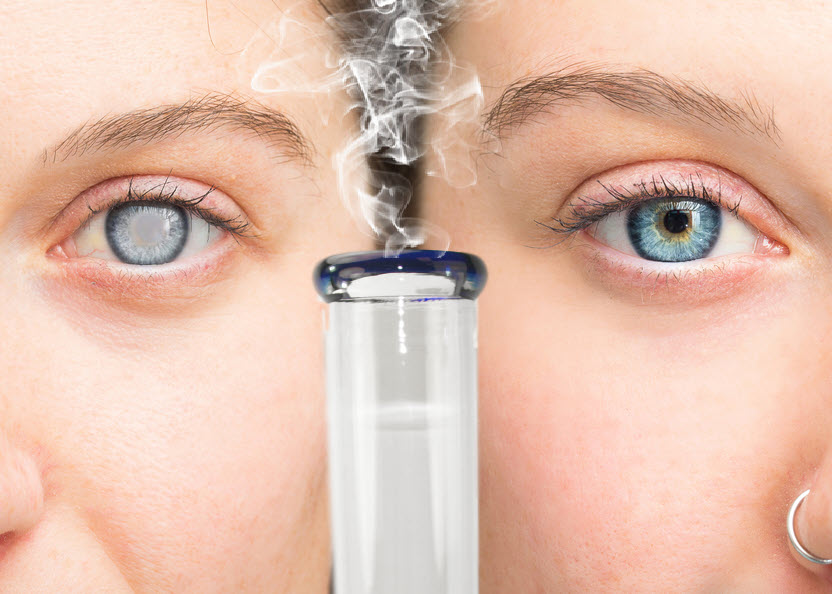
Does cannabis work for glaucoma?
Cannabis versus glaucoma – an ongoing debate in the medical community
Glaucoma is a name used to refer to conditions affecting the eye, particularly the optic nerve, which we rely heavily on for good vision.
Glaucoma is usually associated with a gradual increase in pressure inside the eye, called intraocular pressure. When intraocular pressure damages the optic nerve, it can lead to vision loss and even permanent blindness within a few years if left untreated. It can be difficult to diagnose because many people experience no pain or symptoms in the early stages of glaucoma. The best way to diagnose it early to prevent vision loss is with regular check-ups with your eye doctor.
Once you have glaucoma, you will likely need lifelong treatment. However, if diagnosed early, vision loss can be slowed and permanent blindness prevented.
Current treatment methods for glaucoma include prescription eye drops designed to reduce eye pressure and improve fluid drainage from the eye. More than one type of eye drop may be recommended for severe intraocular pressure. Additionally, depending on how severe the glaucoma is, some patients may be prescribed oral medications and eye surgery in addition to lifestyle changes.
However, cannabis has shown promise in the treatment of glaucoma.
What the latest studies say
At the moment, the medical community is still divided when it comes to the benefits of cannabis for glaucoma. Some agree it works based on the evidence, while others are still on the fence.
Studies showing how cannabis can naturally lower eye pressure date back to 1971. In this study, 11 healthy participants were asked to undergo an eye exam before and after smoking 2 grams of marijuana. The researchers discovered that the observed changes ranged from a 4% increase in intraocular pressure to a 45% decrease. Further studies showed that around 65% of glaucoma patients experienced a 30% drop in pressure after inhaling cannabis and the beneficial effects lasted for 3-4 hours. It should also be noted that the benefits of cannabis in glaucoma were dose dependent.
according to dr Nick Andrew, an eye surgeon, THC is the primary cannabinoid that lowers intraocular pressure by reducing the fluid filling the eye. He adds that THC eye drops are recommended as the ideal route of administration, as the THC compounds only need to reach the eye without having to pass through the nervous system.
In addition, the American Association of Ophthalmology says they do not recommend the use of cannabis to treat glaucoma for people who need to be sober to drive, operate heavy machinery, or go to work because the effect is 3-4 lasts for hours.
But that hasn’t stopped people and pharmacies from recommending it. A 2020 study published in the journal Ophthalmology Glaucoma found that 51% of the dispensaries surveyed recommended the use of marijuana, while others said they were either unsure or deferred recommendations. In addition, they found that 2.6% of glaucoma patients admitted to using cannabis. These numbers show that while many cannabis advocates are working hard to prove the plant’s benefits for glaucoma, many Americans are still not getting the information and care they need for a difficult-to-treat condition.
“Few glaucoma specialists have recommended marijuana for the treatment of glaucoma, and an even smaller percentage of patients report its use for the treatment of glaucoma,” the authors wrote. “In contrast, many pharmacy staff advocate its use. As legal access and public acceptance of marijuana escalates, physicians should be aware of these perceptions when educating patients,” the authors concluded.
according to dr Bret A. Hughes, MD, many glaucoma patients are looking for alternative glaucoma treatments. He explains how it works in the human body to treat this eye condition: “Humans have an endocannabinoid system with receptors that are stimulated by THC and CBD. The body also has naturally occurring cannabinoid receptor ligands, i.e., arachidonoylethanolamine and 2-arachydonoylglycerol, that mimic the effects of THC and CBD in the body.”
“Natural and synthetic cannabinoids interact with the endocannabinoid system to create aqueous production, increase discharge, and provide neuroprotection,” he explained.
It’s also interesting to note that cannabidiol (CBD), another powerful anti-inflammatory compound in cannabis that doesn’t get you high, has been widely used to treat many life-threatening conditions, however, this cannabinoid is not recommended for the treatment of glaucoma. A 2019 animal study found that CBD and THC have different effects on eye pressure; While THC was beneficial in lowering eye pressure by up to 30%, CBD could actually increase eye pressure, which is not good news for glaucoma sufferers.
Conclusion
Many patients across the country are already using cannabis as part of their glaucoma treatments. If your glaucoma is still in the mild stages, cannabis can be of great help, although it is not intended to completely replace all medications and treatments.
Cannabinoids have been shown to reduce intraocular pressure associated with glaucoma. They also have neuroprotective properties, and we anticipate the development of THC eye drops that will greatly benefit glaucoma patients. Research is still being done on how to do this as this presents a challenge considering the surface of the eye may not be able to absorb the cannabinoid eye drops. Water- and oil-based eye drops have not worked based on previous research, so scientists continue to investigate which delivery methods will be more viable in the future.
GLAUCOMA AND WEED, READ MORE…

WHAT’S THE DEAL WITH WEED AND GLAUCOMA? CLICK HERE!

Post a comment: